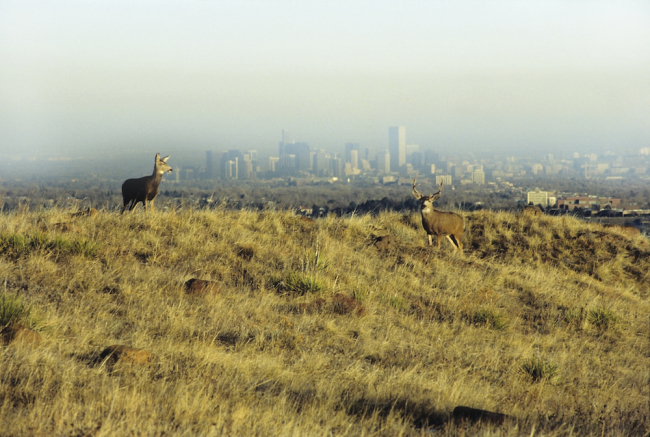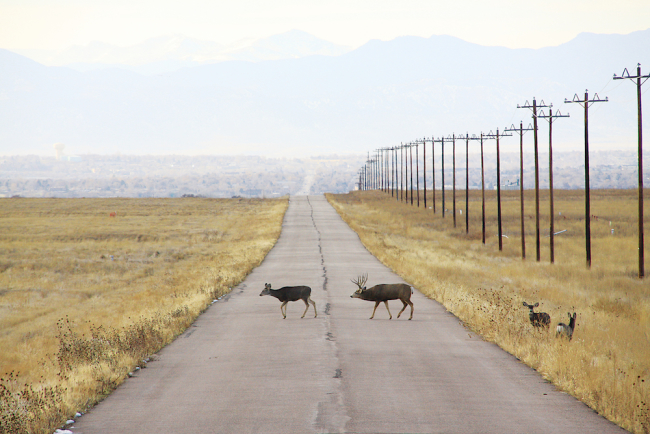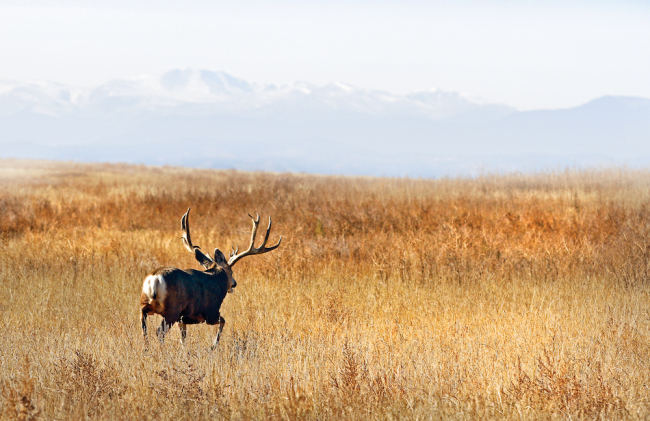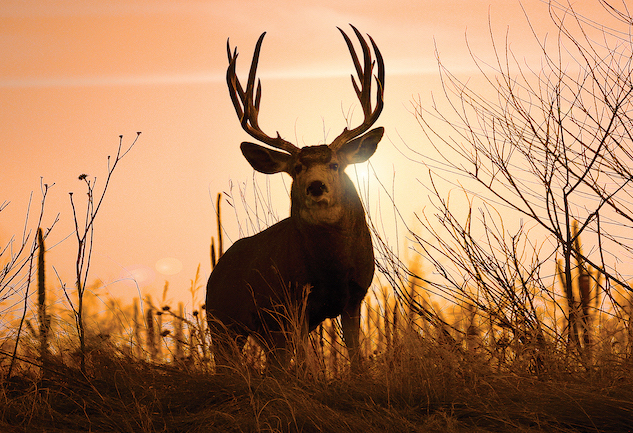A story from our November/December 2016 issue. Not a subscriber? Sign up today!
“The mule deer . . . is a species marked for extinction . . . Either the whitetail deer or man may cause that extinction. Without either, the mule deer could continue unimpeded for as long as habitats exist and the sun rises. It got along well enough with white-tailed deer as long as we were not around, but conditions changed with our arrival.”
That’s Dr. Valerius Geist, Professor Emeritus of Environmental Science at the University of Calgary, renowned expert on the ethology (behavior), biology, evolution, and social dynamics of large North American mammals, in particular elk, moose, bighorn sheep, and deer, writing in his book, Mule Deer Country.
It’s a sobering statement for those of us who love mule deer.
Why the whitetail should be thriving and expanding its range while the mule deer is declining and—possibly—heading for eventual extinction is a hotly debated issue. Mule deer numbers seem to decline wherever they meet up with whitetails, but it is not clear why.
It is not an ecological issue: Even in overlapping or shared areas they tend to occupy different types of terrain based upon different escape and avoidance behaviors.
It’s not an issue of aggression, either. If anything, the mule deer is the more aggressive of the two species when it comes to claiming territory or breeding rights.
Some scientists believe certain kinds of parasites might be to blame, specifically the meningeal worm, yet that particular parasite isn’t even found in some of the areas where whitetails have replaced mule deer.
Some people blame hybridization, but—at least on the face of it—hybridization can be discounted, partly because it occurs relatively rarely, and partly because it produces an animal not well-suited for survival or even reproduction.
However, as Dr. Geist points out, while breeding between mule deer bucks and whitetail does is uncommon due to incompatible breeding behaviors, breeding between whitetail bucks and mule deer does is more common, and every mule deer doe taken out of the available pool means one less mule deer fawn. Couple this with heavy hunting pressure on older (think dominant) mule deer bucks, and extensive but less successful hunting pressure on older (dominant) whitetail bucks (less successful due in part to their more secretive habits and their propensity for becoming completely nocturnal when pressured), and hybridization may be, to a certain extent, a factor. However, that alone is not enough to explain the mule deer’s decline.
Perhaps there is another, less quantifiable, possibility.

A temperature inversion holds air pollution over Denver, Colorado, while a pair of mule deer overlook the skyline from Golden’s South Table Mountain. (Photo: iStock)
In mid-August of 1805 the Lewis and Clark Corps of Discovery passed through the broad Beaverhead River valley area in southwestern Montana. Today the valley is home to the town of Dillon and the University of Montana Western, and is a mecca for hunters and fishermen. Interestingly enough, it wasn’t quite so inviting for Lewis and Clark.
The popular title of The Journals of Lewis and Clark is something of a misnomer because the journals also include plentiful entries by Sergeant John Ordway, Sergeant Patrick Gass, and Private Joseph Whitehouse, as well as a few entries by others. There are almost 5,000 pages of the original journals, and it is refreshing for those of us who rely on spellcheck to see how colorful and imaginative the spelling is by all parties, especially Meriwether Lewis, in spite of his having been President Jefferson’s private secretary. A member of the expedition has trouble with his feet after walking “bearfoot;” mountains “ly parrallel” to the river; Clark takes a different “rout” than Lewis; and Lewis writes about his “sperits [being] much revived” by the sight of a herd of elk, and “game being very scarce and shy.”
Game may have been scarce and shy in 1805, but 210 years later it is only shy. The broad expanse of the Beaverhead Valley that surrounds Dillon is largely agricultural, with very large farms thick with elk and whitetails. The elk are driven down from the surrounding mountains by wolves, and the whitetails are drawn by the easy forage provided by alfalfa, corn, and other crops. Because the elk congregate in large herds, it is easier to estimate their numbers (about 1,200 to 1,500 in a single herd on the western edge of the Schuett Ranch), but the whitetails come together in much smaller units, usually half a dozen to a dozen animals. Only by driving the ranch roads and glassing the vast, level pastures does the magnitude of the aggregate number become apparent.
And magnitude is the right word. Blade Schuett, who along with his father owns the ranch, estimates 1,500 whitetails on 6,000 acres, which works out to more than 150 deer per square mile. To put that in perspective, Ernest Thompson Seton’s estimates for deer densities in pre-European America ranged from 10 to 20 per square mile, an estimate that is still considered to be the ideal number in ideal habitat.
Lewis and Clark would have been thrilled to see that many deer.
In three days on Schuett’s ranch I found just one small group of five mule deer does, and that may be symbolic of the differences between mulies and whitetails as well as the differences between 1805 and 2015.
The mule deer is currently the only western big game species whose numbers are declining. The relationship between elk and wolves has been well documented in areas where elk herds have been greatly reduced (Yellowstone National Park is a good example), but neither whitetails nor mule deer have received the same amount of publicity. Yet when elk numbers drop, either by being predated or because they move to areas like the Schuett Ranch where they feel safe, wolves then turn their attention to deer.
However, it would be disingenuous to lay the blame for the mule deer decline on wolves; mule deer numbers were dropping long before wolves were reintroduced in the mid-1990s. It would be more accurate to lay the blame on man.
Consider again Meriwether Lewis’ observation about game being “very scarce and shy.” Consider again Ernest Thompson Seton’s widely accepted estimate of 10 to 20 deer per square mile in ideal habitat in pre-European America.
Now consider that in many Eastern and Midwestern states, current whitetail numbers are estimated at 75 to 100 deer per square mile, and numbers as high as 400 per square mile exist in some areas.
To put that in perspective, I will quote archaeologist Thomas Neumann’s insightful statement that, “[abnormally high] populations [are] a symptom of an extraordinarily disrupted ecosystem.”

Mule deer cross a road in the Rocky Mountain Arsenal National Wildlife Refuge in Colorado. (Photo: iStock)
Nothing and no one, in all of history, has disrupted ecosystems around the planet the way man has. The overabundance of whitetails in so many areas is proof of that, but if you doubt it, another good example is the snow goose, a species that has increased in such tremendous numbers—more than 300 percent since the 1970s—that their traditional breeding grounds along the Hudson Bay coastline have been completely and irrevocably denuded.
A scientist at Ducks Unlimited tersely summed up the reason for the increase with a single word: nitrogen. He was referring to the fertilizer used in modern agriculture along the snow goose’s traditional flyways: more land in agriculture; more fertilizer being used on that land to create more and better crops; greatly increased food sources for the geese—all of which lead to greatly increased survival rates.
In the case of the mule deer, man’s influence artificially increased their numbers by eradicating or greatly reducing the numbers of predators. At the same time, cattle and sheep were introduced into mule deer territory and supplanted venison as a primary protein source, even as hunting became more and more recreational rather than a matter of survival. The presence of the great herds of domestic animals also changed the forage to shrubs and forbs that mule deer thrive on. Those factors allowed mule deer to increase to unprecedented levels. There is a reason why the 1950s and 1960s are considered the golden age of mule deer hunting.
So why are mule deer declining now? The increase in predators—wolves, mountain lions, and coyotes—is part of it. But more importantly, add to that loss of habitat due to farming, urban sprawl, subdivisions, fences, and interstate highways that bisect winter ranges, migratory routes, and transitional areas. And let’s not forget radical fire suppression in habitat that used to burn and then quickly sprout new green forage for deer.
But to clarify, the primary reasons are that because of man’s influence on the native landscape, and his war on predators, the 1950s and 1960s represented artificially high numbers of mule deer, so that what we consider a decline now may be nothing more than a return to a more normal, pre-European state, a return to the numbers that existed when the Corps of Discovery crew members were relying on wild game to feed themselves.
Add to that a dramatic change in the natural vegetation of the West. Miles Moretti of the Mule Deer Foundation points out that for many years the Federal government encouraged ranchers to plant crested wheatgrass, which supposedly provides better grazing for cattle (many ranchers would dispute that). The resulting monoculture proved devastating to mule deer, a species that has evolved to eat a very specific diet.
At the same time, more and more mule deer habitat was converted into farmland and crops that were unpalatable to mule deer, but favorable to whitetail. Now add overgrazing and invasive species of noxious plants, and the best we can hope for is that the mule deer is headed back down to pre-European numbers.
So what can be done?
I would suggest that our only good option is to leave game management to the professionals, and by professionals I mean qualified scientists and land management experts. State fish and game agencies have a good idea as to the carrying capacity of the land for each game species, and left to their own devices, they are capable of establishing harvest quotas based on the always delicate balance of nature, not on the expectations of any particular group or ideology.
Unfortunately, state fish and game agencies are rarely left to their own devices.
At one extreme is the Federal government, which passes sweeping, one-size-fits-all regulations based on findings of the EPA and various other agencies, that in turn answer to whichever constituents scream the loudest and have the most money.
At the other extreme are the states that allow any damn fool initiative to be placed in front of the public to be voted on by uneducated urban dwellers who think with their hearts instead of their heads. California’s ban on mountain lion hunting is a good example at the state level, but it extends on down to local levels.
In Marin County (California again, natch), cat lovers passed a law making it a crime to shoot a feral or loose domestic cat, never mind that the Audubon Society has stated that the single largest threat to migratory songbirds is cats allowed to run free, and their feral offspring. Narrowly crafted and narrow-minded laws and initiatives such as those protect one species at the expense of another; they do nothing for the balance of nature.
A group of scientists and land managers working for the Nature Conservancy wrote an article arguing strongly that overabundant whitetail deer populations are more of a threat to eastern forests than climate change.

They grow ’em big out West. (Photo: Vic Schendel)
The responses to that reasoned and well-researched article were extraordinary. There were the predictable calls from one side for sterilizing does and reintroducing gray wolves up and down the Eastern Seaboard. (If they reintroduced wolves along Pennsylvania Avenue and on Capitol Hill where they might do some good, I’d be in favor of it.)
On the other side, a hunter from Pennsylvania, which has some of the highest deer density-per-square-mile numbers of any state, wrote angrily that he went an entire season without seeing a single deer. One wonders in what part of the shopping mall he placed his deer stand.
But it is typically and unfortunately representative of the way state fish and game agencies are whipsawed between irreconcilable extremes and unrealistic expectations. If these various state agencies were free of all the political, financial, and ideological pressure and the concomitant media frenzies those pressures create, the mule deer might continue its decline, but it could be slowed considerably.
Mule Deer Foundation
The decline of mule deer and black-tailed deer in North America is real. Anyone who has been deer hunting the last 20 or 30 years has experienced the decline in the number of deer to hunt, places to hunt, and the opportunity to draw a tag.
No one factor contributed to this , and no single factor will bring the deer back. While we will probably never see the numbers of mule deer and black-tailed deer we experienced in the 1950s, ’60s, and early ’70s, I believe there is a brighter future ahead for “The Icon of the West.”
That future depends on us. Sportsmen have always stepped up to help wildlife. The North American Model of Wildlife Conservation is a good example of how a few individuals can make a huge change in how we view wildlife. We must quit focusing on how we hunt mule deer or how many we can kill. Simply increasing the number of mule deer will provide increased opportunity for all of us. More mule deer means more opportunity.
You can’t have big bucks unless you have old bucks. We need a healthy deer herd consisting of good numbers of bucks to ensure breeding occurs over a shorter time period, and healthy adult does producing healthy fawns. Closing hunting seasons or reducing permits does little to improve the herd. We must focus on those things that we can influence or change, and not worry about those that we cannot control.
This is where an organization like the Mule Deer Foundation, which was founded in 1988 in Redding, California, can help. The mission of MDF is to ensure the conservation of mule deer, black-tailed deer, and their habitat.
MDF has accepted the challenge to bring back mule deer populations by restoring or enhancing more than three million acres of habitat. Loss of habitat is the foremost reason behind the decline of mule deer, though predation, highway mortality, wildfires, and the spread of invasive weeds have also had a detrimental impact on deer numbers. With that in mind, in 2016 MDF, in cooperation with state and federal agencies, will complete more than $30 million of habitat restoration projects in mule deer habitat throughout the West.
Last July the Western Association of Fish and Wildlife Agencies Mule Deer Working Group released its status report on mulies and black-tailed deer. In most states, mule deer numbers bottomed out in 2010, but favorable weather the last four years, in conjunction with increased emphasis on deer management by state wildlife agencies, has led to increased numbers of mulies.
To help restore both species, join MDF as a member or volunteer. Find out how you can help at www.muledeer.org.
– Miles Moretti, president and CEO

